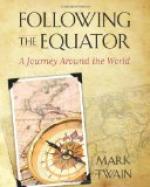His place in art—as to drawing, not color-work—is well up, all things considered. His art is not to be classified with savage art at all, but on a plane two degrees above it and one degree above the lowest plane of civilized art. To be exact, his place in art is between Botticelli and De Maurier. That is to say, he could not draw as well as De Maurier but better than Boticelli. In feeling, he resembles both; also in grouping and in his preferences in the matter of subjects. His “corrobboree” of the Australian wilds reappears in De Maurier’s Belgravian ballrooms, with clothes and the smirk of civilization added; Botticelli’s “Spring” is the “corrobboree” further idealized, but with fewer clothes and more smirk. And well enough as to intention, but—my word!
The aboriginal can make a fire by friction. I have tried that.
All savages are able to stand a good deal of physical pain. The Australian aboriginal has this quality in a well-developed degree. Do not read the following instances if horrors are not pleasant to you. They were recorded by the Rev. Henry N. Wolloston, of Melbourne, who had been a surgeon before he became a clergyman:
1. “In the summer of 1852 I started on horseback from Albany, King George’s Sound, to visit at Cape Riche, accompanied by a native on foot. We traveled about forty miles the first day, then camped by a water-hole for the night. After cooking and eating our supper, I observed the native, who had said nothing to me on the subject, collect the hot embers of the fire together, and deliberately place his right foot in the glowing mass for a moment, then suddenly withdraw it, stamping on the ground and uttering a long-drawn guttural sound of mingled pain and satisfaction. This operation he repeated several times. On my inquiring the meaning of his strange conduct, he only said, ’Me carpenter-make ’em’ (’I am mending my foot’), and then showed me his charred great toe, the nail of which had been torn off by a tea-tree stump, in which it had been caught during the journey, and the pain of which he had borne with stoical composure until the evening, when he had an opportunity of cauterizing the wound in the primitive manner above described.”
And he proceeded on the journey the next day, “as if nothing had happened”—and walked thirty miles. It was a strange idea, to keep a surgeon and then do his own surgery.
2. “A native about twenty-five years of age once applied to me, as a doctor, to extract the wooden barb of a spear, which, during a fight in the bush some four months previously, had entered his chest, just missing the heart, and penetrated the viscera to a considerable depth. The spear had been cut off, leaving the barb behind, which continued to force its way by muscular action gradually toward the back; and when I examined him I could feel a hard substance between the ribs below the left blade-bone. I




